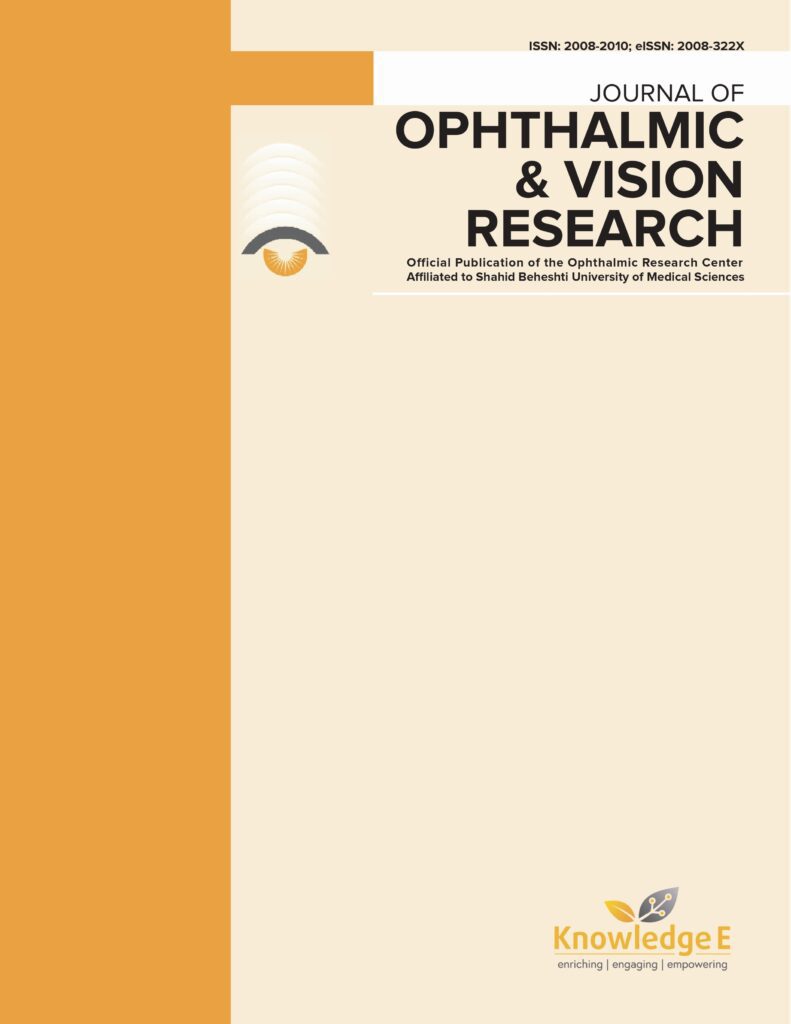
Journal of Ophthalmic and Vision Research
ISSN: 2008-322X
The latest research in clinical ophthalmology and vision science
High Prevalence of Asthenopia among a Population of University Students
Published date: Oct 24 2019
Journal Title: Journal of Ophthalmic and Vision Research
Issue title: October–December 2019, Volume 14, Issue 4
Pages: 474 - 482
Authors:
Abstract:
Purpose: To determine the prevalence of asthenopia and its associated factors in a sample of university students in Iran.
Methods: In this cross-sectional study, participants were selected using multistage cluster sampling. Presence of at least one of the 10 symptoms—foreign body sensation, diplopia, blurred vision, eye swelling, dry eye, eye pain, difficulty in sustaining visual operations, decreased visual acuity, tearing, and photophobia—was considered as asthenopia. Ocular examinations, including uncorrected/corrected visual acuity measurement, objective/subjective refraction, cover test, amplitude of accommodation (AA), and near point of convergence (NPC) were performed.
Results: Of the 1,462 students (mean age: 22.8 ± 3.1 years), 73% were women. The age- and gender standardized prevalence was 70.9% (95% confidence interval [CI]: 68.3–73.5), 39.8% (95% CI: 36.4–43.1), and 19.7% (95% CI: 16.0–23.3) based on the presence of at least one, two, and three symptoms, respectively. The prevalence was significantly higher in females (P = 0.048), hyperopic students (P < 0.001), and astigmatic participants (P < 0.001). The mean AA and NPC were 9.7 ± 2.6 D and 10.2 ± 4.2 D (P = 0.008) and 7.0 ± 2.1 cm and 7.7 ± 3.9 cm (P < 0.001) in participants with and without asthenopia, respectively. Multiple regression model revealed age (28–29 years), astigmatism, and NPC as independent associated factors (odds ratios: 3.51, 1.61, and 0.91, respectively).
Conclusion: This study shows relatively high prevalence of asthenopia in university students. Demographic factors and visual system disorders are important risk factors and timely correction of conditions may lead to decreased asthenopia.
Keywords: Asthenopia, Astigmatism, Photophobia, Prevalence
References:
1. Bhanderi DJ, Choudhary S, Doshi VG. A community based study of asthenopia in computer operators. Indian J Ophthalmol 2008;56:51–55.
2. Garcia-Munoz A, Carbonell-Bonete S, Cacho-Martinez P. Symptomatology associated with accommodative and binocular vision anomalies. J Optom 2014;7:178–192.
3. Ayanniyi AA, Folorunso FN, Adepoju FG. Refractive ocular conditions and reasons for spectacles renewal in a resource-limited economy. BMC Ophthalmol 2010;10:12.
4. Vilela MA, Pellanda LC, Fassa AG, Castagno VD. Prevalence of asthenopia in children: a systematic review with meta-analysis. J Pediatr (Rio J) 2015;91:320–325.
5. Han CC, Liu R, Liu RR, Zhu ZH, Yu RB, Ma L. Prevalence of asthenopia and its risk factors in Chinese college students. Int J Ophthalmol 2013;6:718–722.
6. Wajuihian SO. Frequency of asthenopia and its association with refractive errors. Afr Vis Eye Health 2015;74:74–80.
7. Wiggins NP, Daum KM. Visual discomfort and astigmatic refractive errors in VDT use. J Am Optom Assoc 1991;62:680–684.
8. Mocci F, Serra A, Corrias GA. Psychological factors and visual fatigue in working with video display terminals. Occup Environ Med 2001;58:267–271.
9. Sanchez-Roman FR, Perez-Lucio C, Juarez-Ruiz C, Velez- Zamora NM, Jimenez-Villarruel M. [Risk factors for asthenopia among computer terminal operators]. Salud Publica Mex 1996;38:189–196.
10. Agarwal S, Goel D, Sharma A. Evaluation of the factors which contribute to the ocular complaints in computer users. J Clin Diagn Res 2013;7:331–335.
11. Ostrovsky A, Ribak J, Pereg A, Gaton D. Effects of job related stress and burnout on asthenopia among high-tech workers. Ergonomics 2012;55:854-862.
12. WHO Expert Consultation. Appropriate body mass index for Asian populations and its implications for policy and intervention strategies. Lancet 2004;363:157–163.
13. Vertinsky T, Forster B. Prevalence of eye strain among radiologists: influence of viewing variables on symptoms. AJR Am J Roentgenol 2005;184:681–686.
14. Hashemi H, Khabazkhoob M, Forouzesh S, Nabovati P, Yekta AA, Ostadimoghaddam H. The prevalence of asthenopia and its determinants among schoolchildren. J Compr Pediatrics 2017;8:e43208.
15. Rocha LE, Debert-Ribeiro M. Working conditions, visual fatigue, and mental health among systems analysts in Sao Paulo, Brazil. Occup Environ Med 2004;61:24–32.
16. Ahmed F. Headache disorders: differentiating and managing the common subtypes. Br J Pain 2012;6:124–132.
17. Mvitu MM, Kaimbo WK. [Manifestations of asthenopia in Black subjects]. Bull Soc Belge Ophtalmol 2003;289:45– 49.
18. Digre KB, Brennan KC. Shedding light on photophobia. J Neuroophthalmol 2012;32:68–81.
19. Abdi S, Lennerstrand G, Pansell T, Rydberg A. Orthoptic findings and asthenopia in a population of Swedish school children aged 6 to 16 years. Strabismus 2008;16:47–55.
20. Shima M, Nitta Y, Iwasaki A, Adachi M. [Investigation of subjective symptoms among visual display terminal users and their affecting factors–analysis using log-linear models]. Nihon Eiseigaku Zasshi 1993;47:1032–1040.
21. Stevens GA, White RA, Flaxman SR, Price H. Global prevalence of vision impairment and blindness: magnitude and temporal trends, 1990–2010. Ophthalmology 2013;120:2377–2384.
22. Hashemi H, Khabazkhoob M, Yazdani N, Ostadimoghaddam H, Derakhshan A, Soroush S, et al. The prevalence of refractive errors among Iranian University students. Iran J Ophthalmol 2014;26:129–135.
23. Schellini S, Ferraz F, Opromolla P, Oliveira L, Padovani C. Main visual symptoms associated to refractive errors and spectacle need in a Brazilian population. Int J Ophthalmol 2016;9:1657–1662.
24. Daum KM, Good G, Tijerina L. Symptoms in video display terminal operators and the presence of small refractive errors. J Am Optom Assoc 1988;59:691–697.
25. Kotegawa Y, Hara N, Ono K, Arimoto A, Mukuno K. [Influence of accommodative response and visual symptoms on visual display terminal adult operators with asthenopia through adequately corrected refractive errors]. Nippon Ganka Gakkai Zasshi 2008;112:376–381.
26. Abdi S, Rydberg A. Asthenopia in schoolchildren, orthoptic and ophthalmological findings and treatment. Doc Ophthalmol 2005;111:65–72.
27. Kaufmann H, H. S. Heterophorie und Asthenopie. In: Ru¨ssmann WGK, editors. Strabismus: Thieme;2012:119– 221.
